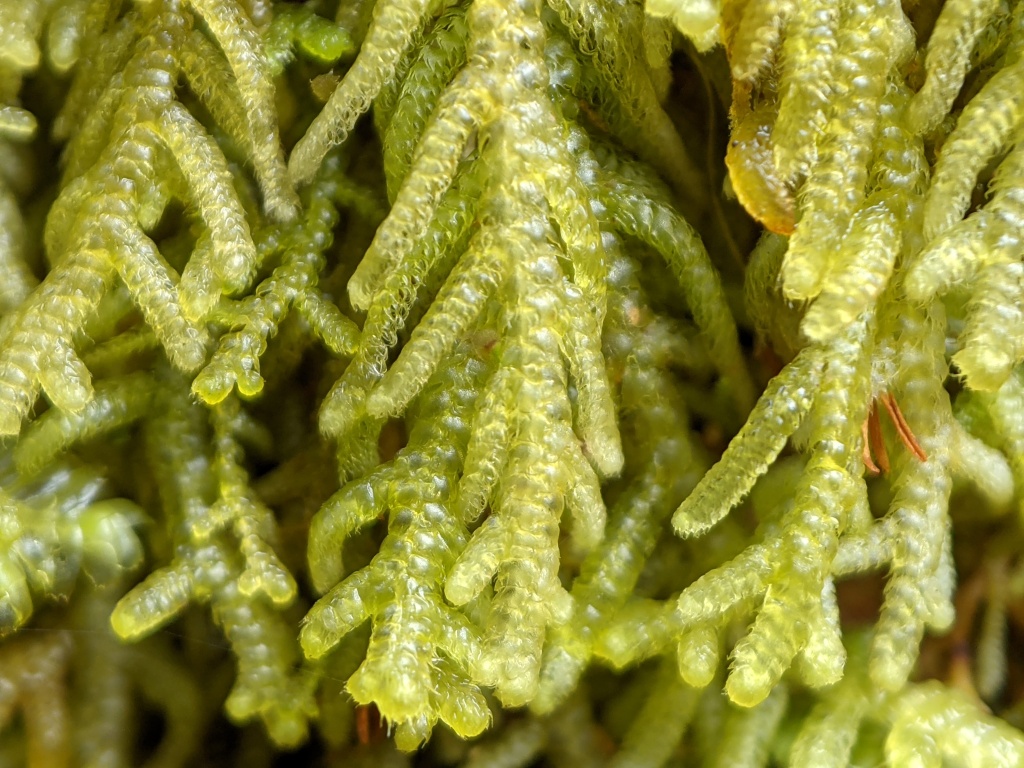Lepidozia
Epiphytic, on logs, lithophytic or terrestrial, dioecious or rarely autoecious (not in Victoria). Asexual reproduction rarely by caducous leaf lobe apices (not in Victoria). Stems erect or prostrate, irregularly branched or regularly 1–3-pinnate; branches emerging from stem abaxial to lateral leaf with fewer lobes and without a collar at base, often becoming attenuate and with reduced leaves, rarely emerging from beside an underleaf with fewer lobes and without a collar of tissue at base (not in Victoria), sometimes emerging from stem near unmodified underleaf and with a collar of tissue at base and without normal leaves. Lateral leaves ovate and unlobed (not in Victoria), oblong-ovate and bifid (not in Victoria), or quadrate to cuneate or semicircular in outline and shallowly to deeply 3–5-lobed, sometimes with accessory lobes making leaf appear up to around 12-lobed, asymmetric and usually with acroscopic margin curved and longer than basiscopic margin, or symmetric (not in Victoria), incubous or transverse (not in Victoria), spreading to appressed to stem (not in Victoria), remote to imbricate, collectively green, yellowish green, glaucous or brownish, entire or dentate, unistratose, rarely with basal margin incurved to form water sac (not in Victoria); lobes usually unequal, triangular to ciliate (not in Victoria), entire, dentate or ciliate, sometimes deeply divided into accessory lobes, acute. Underleaves much smaller than lateral leaves, ovate and unlobed (not in Victoria) or quadrate to cuneate or semicircular in outline and 2–4-lobed, entire, dentate or ciliate. Leaf cells polygonal to quadrate or oblong, rarely becoming conspicuously more elongate in lobes (not in Victoria), smooth or papillose, thin- to firm-walled, without or rarely with (not in Victoria) distinct trigones, with 1–23 spherical, ellipsoid or ovoid and homogenous (not in Victoria) to granular-botryoidal oil bodies. Rhizoids in fascicles at bases of underleaves on creeping stems, concentrated on microphyllous branches in erect species. Androecia forming short branches emerging from underleaf or rarely lateral leaf axil, with saccate bracts, each with 1–2 antheridia. Sporophyte at apex of short branch emerging from abaxial stem, subtended by several series of bracts; bracts ovate to ovate-oblong, usually less deeply lobed than leaves, rarely more deeply lobed (not in Victoria). Perianth fusiform to ellipsoid, terete at base becoming trigonous or with 3 plicae toward mouth; mouth crenulate to ciliate (not in Victoria). Capsule ellipsoid to obloid, 3–6-stratose; elaters bispiral. Spores spherical, granular-papillate or vermiculate, light- to red-brown.
One hundred and forty-five species, mostly in Australasia, Malesia and southern South America, but widespread in temperate to tropical regions elsewhere (Schuster 2000; Engel & Schuster 2001; Söderström et al. 2016); five species in Victoria.
Engel, J.J. & Schuster, R.M. (2001). Austral Hepaticae. 32. A revision of the genus Lepidozia (Hepaticae) for New Zealand. Fieldiana, Botany 42: 1–107.
Schuster, R.M. (2000). Austral Hepaticae Part I. Nova Hedwigia Beiheft 118. Cramer in der Gebrüder Borntraeger Verlagsbuchbehandlung: Berling & Stuttgart.
Söderström, L., Hagborg, A., von Konrat, M., Bartholomew-Began, S., Bell, D., Briscoe, L., Brown, E., Cargill, D.C., Costa, D.P., Crandall-Stotler, B.J., Cooper, E.D., Dauphin, G., Engel, J.J., Feldberg, K., Glenny, D., Gradstein, S.R., He, X., Heinrichs, J., Hentschel, J., Ilkiu-Borges, A.L., Katagiri, T., Konstantinova, N.A., Larraín, J., Long, D.G., Nebel, M., Pócs, T., Puche, F., Reiner-Drehwald, E., Renner, M.A.M., Sass-Gyarmati, A., Schäfer-Verwimp, A., Moragues, J.S., Stotler, R.E., Sukkharak, P., Thiers, B.M., Uribe, J., Váňa, J., Villarreal, J.C., Wigginton, M., Zhang, L. & Zhu, R. (2016). World checklist of hornworts and liverworts. Phytokeys 59: 1–828.
 Spinning
Spinning